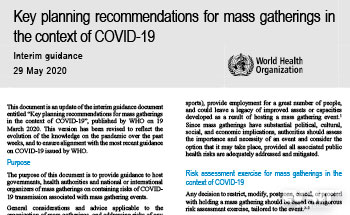
01 Jun The Event Industry as WHO Issues new Guidelines for Mass Gathering
The World Health Organization issued new guidelines for outdoor events and mass gatherings. Here is what you need to know.
Countries are approaching mass gatherings in very different ways. There is consensus that super-spreader events are how the virus began to spread so rapidly — hence the extra level of attention and security on behalf of justifiably cautious governments.
However, the need for security is leading to confusion.
A case in point is Italy, one of the most highly-impacted countries, which recently saw outdoor events of up to 1,000 attendees permitted, but no indoor meetings are allowed. That caused an uproar in the local event community leading to numerous associations writing to the government for more clarity and direction.
Within this climate, the WHO’s latest guidance creates even more confusion among event professionals. The document has some positives but leaves too much to interpretation, and that is never a good thing in the exact science of planning events,
Here are the key points:
Mass gatherings are still seen as cause for virus spread.
“In the context of COVID-19, mass gatherings are events that could amplify the transmission of the virus and potentially disrupt the host country’s response capacity.”
The WHO nevertheless understands the necessity of events.
“Since mass gatherings have substantial political, cultural, social, and economic implications, authorities should assess the importance and necessity of an event and consider the option that it may take place, provided all associated public health risks are adequately addressed and mitigated.
Contagion levels dictate the need for events.
“In countries that are implementing strict movement and physical distancing measures aimed at decreasing transmission of COVID-19, it is unlikely that authorities will allow mass gatherings to take place. […] However, in countries where restrictive measures are being progressively adjusted in response to an evolving epidemiology, the decision to proceed with an event, and how to proceed, becomes highly relevant.”
Risk Factors to Assess
1. Venue: Location, size/type, indoor/outdoor, crowd density.
2. Attendees: Age, health status, provenance, international/local travel to event.
3. Event activities: The expected interactions among participants occurring during the event (closeness of contact, etc.).
4. Duration: How long the event and particular sessions will be, and how long attendees will be expected to be together in enclosed spaces.
5. Local healthcare infrastructure: The policies, resources, and capacities at the host country’s disposal to detect and manage cases of COVID-19.
Planning Phase
Communication: A plan to establish links to all relevant health authorities and key stakeholders.
Preparedness plan: The key elements here being the detection and monitoring of COVID-19 cases and a plan of action when these are identified.
Capacity and resources: Planners should allocate resources and isolation rooms for potential cases.
Operational Phase
What sticks out in this part of the document is the recommendation from the WHO to host a portion of the event online — essentially hybrid events. This is a very direct confirmation of what we anticipated in our article about the near future of events.
Another interesting aspect is communication. A clear message needs to go out to those at higher risk of transmitting COVID-19 that they should not attend. This also extends to those who are (or are in close contact with) vulnerable people at risk developing a serious illness.
In line with our previous recommendations, the duration of the event should be kept to a minimum to minimize the potential spread of the virus.
Assess Your Risk
The WHO has developed a tool to assess your risk. You can download the spreadsheet here. It will assign a numerical value to your risk factors and guide you through decisions.
The full document with the guidelines is available here.
Industry Reactions
The industry welcomes these changes with mixed feelings:
Karen Hartline CMP, a Las Vegas-based event professional commented:
“These suggestions are nice, in theory, but I don’t know how realistic they are right now. An outdoor venue likely won’t work for most conferences. Shortening the duration of the event may mean people won’t come or they’ll gather socially outside of the event hours. Having isolation facilities onsite could be costly to the event organizer. I’m also curious if events would make masks legally mandatory if they could, depending on the state their event takes place in.”
She also added “as an in-house corporate planner, we’re seriously reviewing an option that would not allow for event travel for the remainder of the year. That’s something planners need to take into consideration as well. If your attendee audience is corporate, they may not be willing to risk requiring employees to attend in-person events for a while.”
Matthew Donegan-Ryan, of event technology company Swapcard, added:
“This guidance basically gives local authorities the credibility to set whatever rules they want and justify them by saying it’s supported by WHO. WHO should give specific guidance on volumes/density/times between cleaning etc.”
Dan Berger, founder of Social Table and event industry entrepreneur:
“It’s great to see the WHO acknowledging the importance of face-to-face events and working with governments to ensure they re-start but in a safe and orderly way.”
Cindy Lo, CEO and Chief Event Strategist of Red Velvet Events:
“I appreciate that WHO is recognizing us as an industry, but since each country/US county can set the attendee maximum, my recommendation is for those planning US meetings is to plan for virtual and hybrid for the next 3-6 months. Let’s show WHO how we are doing these safely and creatively to set a basis for updated guidelines, and then we can safely get back to physical and larger hybrid events in 2021. But first, US cities and county leaders need to push out clear and reasonable terms as to what’s allowed and not allowed so we can even host a group larger than 10.
It’s going to definitely take some adjustment to this but I am confident that our industry will come out stronger and better for over-coming this challenge.”
The Long Road Ahead
It’s encouraging that these guidelines add more prominent calls for virtual events, but the lack of objective criteria to follow makes it difficult to take a ‘one size fits all’ systematic approach.
Granted, different locations are in different conditions, but this will potentially add to the confusion and disparity of approaches in different countries regardless. As many in the industry affirm, shutting down was a breeze, but opening up is extremely challenging.
Another problem with local governments independently taking different approaches is that it potentially creates a misguided perception that those that are more receptive to business meetings and economic recovery are legitimately safer. As a result, some event planning communities risk a competitive disadvantage in the longer term by continuing to prioritize health and safety.
A $1 trillion industry is on its feet and desperate for guidance. Associations, governments and health organizations seem to struggle with giving clear leadership on when things could go back to normal. It seems that only a steep decrease in cases or a breakthrough event (vaccine, cure or herd immunity) could solve the issues the industry is facing once and for all.
The situation gives rise to a legitimate question:
How is it possible that, three months into the biggest crisis ever faced by the industry, governments still fail to understand the impact events have on economies and how vital it is to bring them back to life?
Source:https://www.eventmanagerblog.com/who-guidelines-mass-gatherings/

No Comments